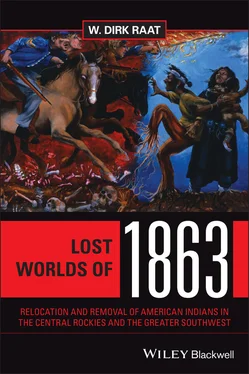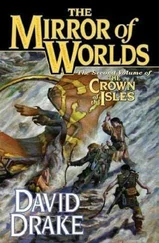Then in 1878 the Bannock War erupted, lasting from June to August 1878. A combined force of about 500 Bannock, Northern Shoshone, and Paiute warriors fought the US Army and a variety of militia and volunteer groups. The early fighting took place outside of Fort Hall, Idaho, and at Camas Prairie near the Snake River, but the later phases involved the army pursuing Egan and his warriors through the Steens Mountains and Silver Creek area south and west of the Malheur Reservation. Both the Bannock leader Buffalo Horn and the Paiute War Chief Egan were casualties of the war. When the fighting subsided most of the Bannocks returned to Fort Hall. There their connections with other tribal groups were restricted. The Paiutes at the Malheur Reservation were removed to Fort Harney, and from there 543 Bannock and Paiute prisoners of war were sent to internment at the Yakama Indian Reservation north of the Columbia River in Washington. Most of the Paiutes had not participated in the war, but their innocence was not recognized by the federal government. Because of pressure from settlers, the Malheur Reservation was “discontinued” in 1879. 92
When the first orders were sent out, it was said that all the Paiutes on and off the Malheur Reservation were to gather at Fort Harney so that they could be provisioned and returned to the Malheur Reservation for the coming winter. This included Paiutes still remaining in Camp McDermit and environs, excluding Winnemucca’s band. Although the gathering Paiutes were treated well at Fort Harney, their suspicions were heightened when they observed the settlers moving onto the reservation, constructing cabins, and preparing fences for their livestock, without the military taking any action. Then the bad news was delivered—all of the Paiutes assembled at Fort Harney were to be treated as prisoners of war and forcibly marched to the Yakima Reservation in Washington. 93
On January 6, 1879, the journey to Yakima of 350 miles over mountains and snow began. While the agency at Yakima constructed a shed for 543 prisoners, the exact number of people who marched to Yakima cannot be known with certainty. Winter clothing was inadequate, especially for the women and children. Soldiers dragged the women and children to the wagons, while the men moved slowly through the snowdrifts shackled in chains. The casualties were remarkably light, with at least one old man, one woman who had given birth the day before, and at least four or five infants dying on the trek. They arrived on January 31 after a twenty-five-day trip on their own “Trail of Tears.” 94
As exiles the Yakima Indians would treat them as inferiors, and steal their horses and clothing. 95In 1883 most of the Numu returned to Nevada on their own, some returning to Pyramid Lake, others to Fort McDermit, and the remainder to the Duck Valley Reservation on the border between southwestern Idaho and north-central Nevada. 96
After 1889 those who did not receive allotments of land or were dissatisfied with the actions of the Indian agents, strove to solve their problems through other means. Most settled outside the reservations, attaching themselves to ranch families or living in colonies on the outskirts of Nevada cities. Here the women would labor as dishwashers, launderers, or housekeepers, while the men took jobs from chopping wood and doing farm chores to feeding livestock and stacking hay. Others hunted rabbits and squirrels, and took fish and game for sale. 97
And most of them, on and off the reservation, continued their “pernicious” fandangos that irritated Agent Rinehart for so many years. But now the dance of communion, the traditional Round Dance, would usher in an Indian millennium in which all would be “peace,” and “good will” would prevail between men and women of all colors. 98The new era would be a return to the golden age of the past before their white brothers came to the Sierra. The Round Dance was known to outsiders as the Ghost Dance.
Afterthought: Desert Ghost Dancers
As has been noted, the Civil War years were a period of extreme colonialism and militarism in the history of the Greater Southwest. The Indian response, in the face of white encroachments that threatened their identity by destroying their subsistence economies, shrinking their populations because of warfare and disease, and assimilation programs that amounted to cultural genocide, was to adapt and survive by creating a kind of religious Indian nationalism. For many Indian groups the so-called Ghost Dance movement was a statement of identity and a worldview that continued from the early nineteenth century well into the twentieth century.
It was a pan-Indian, traditional religious belief system as well as a reaction to external conditions that deprived them of their distinctiveness. The Ghost Dance was in the tradition of the Round Dance, a ceremonial activity that would bring about regeneration and growth. This kind of doctrine could be used to develop a sense of Indian pride and social cohesion in the face of overwhelming white dominance, or it could become a message of defiance. In fact, it was both depending on the individual and his/her circumstance. Whether actively hostile to whites or passively accepting white dominance, the movement was a significant expression of Indian identity. 99
Although the antecedents to the phenomenon of the Ghost Dance reach back to colonial times in US history, it is likely that the inspiration for the 1870 Ghost Dance vision of the Walker Lake Paiute Wodziwob (Grey Hair) was the Prophet Dance, the Dreamer religion of the Wanapum prophet Smohalla. The Prophet Dance movement spread from the Athapascans of British Columbia to the Paiutes in southern Oregon, and its teachings predicted that a great earthquake would eliminate the white man leaving the Indians to enjoy the fruits of the earth. Smohalla, who very likely was influenced by Mormon missionaries, traveled from Washington State to Mexico, Utah, and Nevada in the 1860s a few years before Wodziwob had his mystical trance and vision. 100
In 1870, when Wodziwob came out of his trance he reported his trip to heaven and said that the spirits of the dead were returning to earth to usher in a “heaven on earth”—an earthly paradise. To understand Wodziwob his shamanism must be taken into account. He was a Paiute magician who could control supernatural forces, and he did this by ventriloquism, hypnosis, and sleight-of-hand tricks. He allegedly had the power to remove foreign bodies from the sick and force out the evil forces possessing a patient’s body. And like the shaman-warrior Geronimo, it was claimed that arrows and later bullets would bounce off his body. 101
There were other precedents for Wodziwob, including the activities of Wazadzzobahago in 1860, who, as head medicine chief of the Mono Lake Paiutes, supposedly was killed and burned only to be resurrected in three days when he arose from the ashes. On that third day a whirlwind came and raised the ashes in the form of a pillar. Mention has already been made of Wahe, the brother of Old Winnemucca, who professed to be a spirit chief and as such was protected from the bullets of his enemies. Wahe, it will be remembered, led the Indian conspiracy against Fort Churchill in 1861. 102Later on, when the Paiutes were at the Malheur Reservation in 1875, Oytes, the Dreamer chief, planned to kill Agent Parrish, and told his followers that his shamanistic powers were so great that bullets could not touch him. 103
Thus, dances, ceremonial practices, and religious beliefs similar to the Ghost Dance tradition were well established both before and after Wodziwob’s 1870 trance. Wodziwob’s disciples spread the doctrine beyond Walker Lake. In the Mason and Smith valleys of Nevada, areas west of Walker Lake on the Walker River, Numa-taivo, the father of Wovoka (Jack Wilson) not only taught the tricks and ideas of shamanism to his son, but carried the Ghost Dance message throughout the area. An equally enthusiastic disciple, Weneyuga, spread the religion to the Washoe people. 104Others who were some of the first to receive the message were the Modoc people of northeastern California and the Klamath River tribes. From these regions the Ghost Dance of the 1870s went southward through the Monos, the Tule River Indians, the Panamint of Death Valley, the Chemehuevi, and Mojave. All of these were groups that had experienced dislocation and cultural decay for 20 years since California had become a state in 1850. 105
Читать дальше












